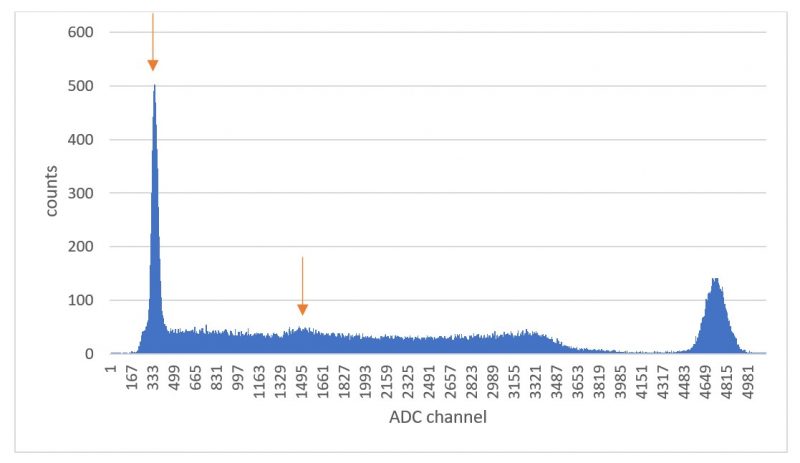| Difficult | Execution Time | Data Analysis | Radioactive Sources |
|---|---|---|---|
| Yes | Yes |
Hardware setup
This experiment guide is referred to the SP5600EMU educational kit.
Equipment
- SP5600EMU– Emulation Kit
- Additional Gamma Radioactive Source

This experiment is also possible with the following kits: SP5600C, SP5600AN, SP5640, SP5630EN, SP5600ENP.
Purpose of the experiment
Study the characteristics of the 137Cs spectrum, with special relevance given to the low energy spectrum. The student can learn effects related to the experimental observation of a gamma decay and have basic information about the experimental setup used in gamma spectroscopy. Estimate the energy of the backscatter peak and of the Kα line.
Fundamentals
The Compton effect is linked with experimental issues, since it is caused by the interaction of photons with the electrons instrument that measure the gamma radiation. In a real detector setup, some photons can and will undergo one or potentially more Compton scattering processes (e.g. in the housing material of the radioactive source, in shielding material or material otherwise surrounding the experiment) before entering the detector material. This leads to a peak structure, the so-called backscatter peak.
The basic principle for the backscatter peak formation is the following: gamma-ray sources emit photons isotropically, some photons will undergo a Compton scattering process with a scattering angle close to 180° and some of these photons will subsequently be detected by the detector. The result is an excess of counts in the Compton part of the spectrum, the so-called backscatter peak. This peak has an energy approximately equal to the photopeak energy minus the Compton edge energy.
The 137Cs gamma photopeak at 661 keV is responsible also for a low energy emission (i.e. emission of an X-ray). This is due to the decay mechanism of137 Cs: it decays via β decay into an excited state of barium-137, which than passes to the ground state, giving rise to the 661 keV photopeak. Emission of a 661 keV γ photon is not the only way excited barium gives off its energy. In some cases barium-137 can transfer its energy to an electron of its 1s atomic shell (“internal conversion“). The hole in the 1s shell is replenished from higher shells. This process gives rise to the emission of the characteristic X radiation of barium, which is the Kα line nearly at 32 keV (X rays are photons in the range 100 eV-100 keV).
Carrying out the experiment
To perform the experiment, connect the DT4800 output to the input channel of the MCA DT5770 and use the DT4800 GP0 as digitizer “trigger IN”. The Emulation Control Software Interface allows user to generate exponential decay signals with programmable rise time and fall time and it is possible to emulate signals from 137CsI radioactive. The spectrum can be recorded and analyzed by the MCA.

Experimental setup block diagram for the experiment.
Results
The user can calibrate the system by using the spectrum itself. The backscatter peak and the Kα line can be identified. After calibrating the spectrum, it is possible to estimate the energy of the two peaks and compare them with theoretical predictions.

Plot of the 137Cs spectrum acquired by the MCA. The backscatter peak and the Kα line are indicated with the red arrows.


